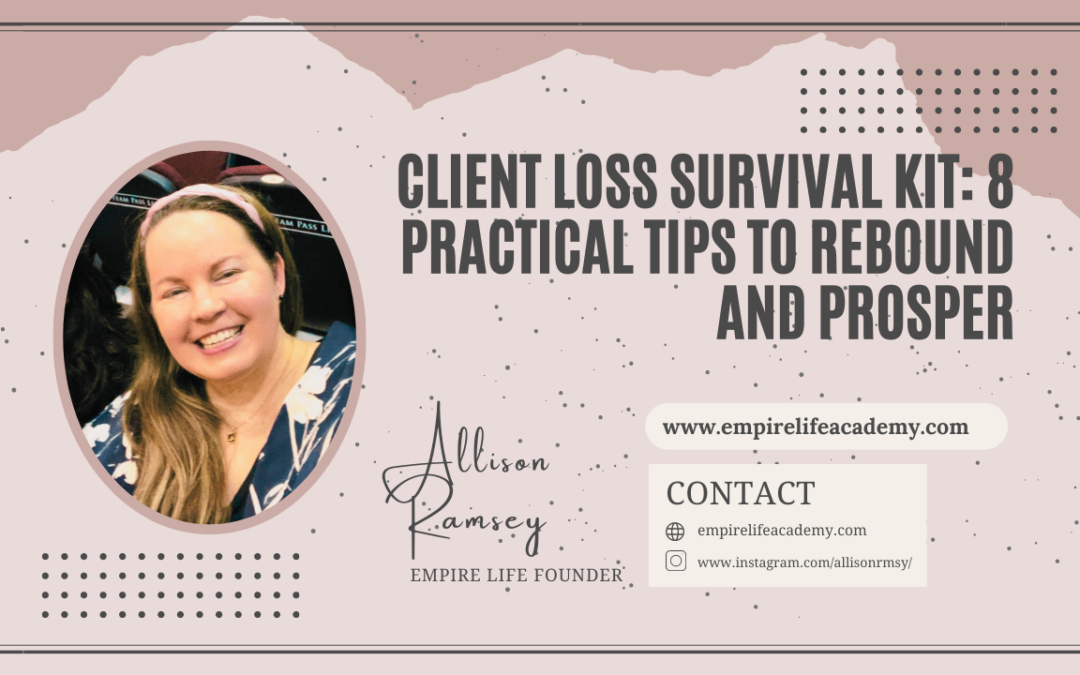Client Loss Survival Kit: 8 Practical Tips to Rebound and Prosper
Losing a client can be an emotional experience, especially if you’ve invested time and effort in building a relationship with them. It’s natural to feel a sense of disappointment or even a bit of self-doubt during such situations.
Also, it’s essential to remember that clients can leave for various reasons, some of which may be beyond your control. Changes in their business needs, budget constraints, or even personal circumstances can influence their decision.
While it can be hard to accept, the best thing you can do is move on and focus on securing new clients. Here are eight ways to make the most of losing a client:
———–
Your Business ROI
All of coaches and female-led businesses who implemented Empire Life’s business strategies in client leads, monthly income (often a 20X increase from when they started with Empire Life’s support), and client retention after having Empire Life Mentorship, apply here.
————–
Assess the Situation
Losing a client can be a challenging and disheartening experience, and it’s essential to take the time to assess the situation thoroughly. While it may be tempting to move on quickly, understanding the reasons behind the loss can offer valuable insights for improvement and growth. This process allows us to learn from our mistakes, strengthen our relationships with existing clients, and enhance our services for future clients.
Firstly, assessing the situation provides an opportunity for introspection. We need to ask ourselves tough questions and reflect on any missteps or shortcomings that may have contributed to the client’s departure.
Here are some essential questions to ask yourself when assessing the situation:
- What were the specific reasons for the client’s departure?
- Were there any signs of dissatisfaction that we might have overlooked?
- Did we fully understand the client’s needs and expectations?
- Did we communicate effectively with the client throughout the relationship?
- Were there any service or product issues that contributed to the client’s decision?
- Did we deliver on the promises made during the initial engagement?
- How did we handle any problems or challenges that arose during the client relationship?
- Did we actively seek feedback from the client during their time with us?
- Were there any internal processes or procedures that might have hindered client satisfaction?
- Did the client receive enough attention and support from our team?
- Did the client feel valued and appreciated during their engagement with us?
- Did we go above and beyond to meet the client’s unique needs?
- How did we compare to competitors in the eyes of the client?
- Did the pricing structure align with the value provided to the client?
- Were there any missed opportunities to upsell or cross-sell additional services?
This self-analysis helps us identify areas that require attention and ensures we don’t repeat the same errors in the future. By acknowledging our weaknesses, we can take proactive measures to address them, ultimately enhancing our service delivery.
Communicate With Your Team
Sharing the news of losing a client with your team creates transparency and trust. Being upfront about the situation helps everyone understand the challenges the business is facing and fosters a culture of openness. This kind of environment allows team members to feel comfortable sharing their thoughts and ideas, which can lead to valuable insights and potential solutions.
Secondly, discussing the loss with your team provides an opportunity to assess what went wrong. Identifying the factors that contributed to losing the client is essential for learning from mistakes and improving processes. Brainstorming and analyzing the situation together can lead to valuable lessons and help prevent similar issues in the future.
Now, let’s talk about the planning structures you can employ:
Team Meeting: As soon as you’re aware of the lost client, schedule a team meeting. In this meeting, be transparent about the situation, share the reasons behind the loss, and encourage everyone to voice their thoughts and concerns.
Lessons Learned: Conduct a thorough analysis of what led to the client’s departure. It could involve reviewing communication logs, feedback, and performance data. Use this information to develop actionable insights.
Action Plan: Based on the lessons learned, collaboratively create an action plan. Set clear goals, assign responsibilities, and establish a timeline for implementation. By involving the team in the process, they’ll feel more invested in the solution.
Encouragement and Support: Losing a client can be tough on the team morale. As a leader, offer support, encouragement, and emphasize that setbacks are a natural part of business. Reassure them that their efforts are valued and that the team will bounce back stronger.
Continuous Improvement: Communicate the action plan’s progress regularly and keep the team updated on any changes in strategy. Encourage a culture of continuous improvement where everyone feels empowered to contribute ideas and solutions.
Reach Out to Other Clients
Maintaining a steady flow of clients is essential for business growth. Losing a client may create a temporary gap in revenue, so connecting with new prospects ensures ongoing success. That’s why diversifying your customer base is crucial. Relying heavily on a single client can be risky, as their needs or circumstances may change unexpectedly. By expanding your client roster, you build resilience and reduce dependency on any one client.
Additionally, reaching out to new clients allows you to showcase your unique offerings to a broader audience. It’s an opportunity to demonstrate how your business can address their specific needs and solve their problems effectively.
Now, let’s discuss cold emailing.
It can be an effective strategy for business growth if approached correctly. Personalization and relevance are key. Avoid generic, mass emails that feel like spam. Instead, research the recipient’s company and tailor your message accordingly. Show that you understand their challenges and how your solutions can benefit them.
Keep your email concise, engaging, and professional. Busy professionals appreciate clear and direct messages that communicate value.
————–
For the female businesses who are scaling, who are already making over $20,000USD-$40,000USD per month, there needs to be a different and unique level of support, just for you. This leads me to our mastermind (doors opening soon!!), and masterminds in general to be a part of, contact us and apply here.
————–
Focus On Your Strengths
Focusing on your strengths helps you maintain confidence in your abilities and what your business has to offer. Losing a client might lead to self-doubt, but reminding yourself of your strengths can boost your morale and keep you motivated to bounce back.
Secondly, capitalizing on your strengths allows you to identify what sets you apart from your competitors. Understanding your unique selling points helps you better target potential clients who align with your strengths and value what you bring to the table.
Moreover, emphasizing your strengths enables you to communicate your value proposition effectively. When reaching out to new clients or discussing potential partnerships, showcasing your strengths helps them see why working with you can be a game-changer for their business.
———–
Have you had a chance to grab our best-selling book, with women’s stories of their rising to success, and Redefining their success?
If you want to be featured in the upcoming book RECLAIM, Series 2, are you a female founder, with an incredible story to share with millions to inspire them, apply here.
———–
Stay Positive
Losing a client can be an incredibly challenging experience for any business owner. It’s natural to feel a range of negative emotions such as sadness, frustration, and disappointment in such situations.
One of the key factors that can contribute to these negative emotions is the personal attachment we may have developed with our clients, particularly if we have had a long-standing working relationship with them. When a client chooses to leave, it can feel like a personal rejection, causing a sense of sadness and disappointment that can be difficult to shake off.
Additionally, the financial impact of losing a client can be significant, especially if they were a major source of revenue for our business. This sudden loss of income can trigger stress and anxiety about the future financial stability of our company, creating further feelings of unease.
Another common emotional response to losing a client is the fear of failure. It’s not uncommon for business owners to question their own abilities and worry that this loss signifies their inadequacy. This fear may extend to future client relationships, with concerns about losing additional clients in the long run.
The uncertainty that follows losing a client adds to the emotional toll. It’s natural for business owners to worry about how they will replace the lost revenue and attract new clients to sustain their operations. This uncertainty can amplify the negative emotions, creating a sense of unease about the future of the business.
Lastly, losing a client can have a profound impact on our trust in ourselves and our business. The departure of a client may lead us to question our ability to deliver quality services and may even cast doubt on our entire business model. These doubts can further erode our confidence and leave us apprehensive about the loyalty of our remaining clients.
———–
Have you joined Quora yet? To speak your mind, ask questions, and display yourself as an expert there.
———–
Stay Organized
Losing a client can be disheartening, but it’s essential to stay organized and focused during this challenging time. Here’s a step-by-step guide to help you navigate through the aftermath of losing a client and get back on track in a conversational, professional tone:
Step 1: Take a moment to reflect
It’s natural to feel disappointed when you lose a client, but it’s essential to take a step back and reflect on the situation. Analyze what went wrong, whether it was within your control or not, and identify any areas where you can improve.
Step 2: Review your contract and communication
Go back to your client contract and review the terms, cancellation clauses, and any relevant agreements. Ensure you follow the proper procedures outlined in the contract. Additionally, analyze your communication with the client to see if there were any signs of dissatisfaction that you might have overlooked.
Step 3: Evaluate your pipeline and financials
Assess the impact of losing the client on your business’s financials. Review your current pipeline to see if there are any potential new clients or projects that can help mitigate the loss. Adjust your budget and financial forecasts accordingly to accommodate the change in revenue.
Step 4: Organize client data and feedback
Keep your client data organized and up-to-date. This includes contact information, past project details, and any feedback received. Learning from client feedback can help you improve your services and prevent similar issues in the future.
Step 5: Reach out to the client (optional)
If the circumstances allow and the relationship ends amicably, consider reaching out to the client for feedback. Express your gratitude for the collaboration and ask for constructive criticism. This approach shows professionalism and a willingness to learn and grow.
Step 6: Focus on retention and referrals
Shift your focus to retaining your existing clients and encouraging referrals. Provide exceptional service and personalized attention to your current clients to strengthen your relationships and increase the likelihood of repeat business or referrals.
Step 7: Reevaluate your marketing strategy
Take the time to reassess your marketing efforts. Identify any gaps in your outreach and promotional activities and develop a plan to enhance your marketing strategy. Utilize online platforms, social media, and networking to increase your visibility and attract new clients.
Step 8: Set new goals and objectives
Losing a client can be an opportunity for growth. Set new goals and objectives for your business, taking into account the lessons learned from the loss. Aim for realistic, measurable, and achievable targets to stay motivated and track your progress.
Step 9: Stay proactive and adaptable
In a competitive business landscape, staying proactive and adaptable is crucial. Continuously monitor industry trends, client preferences, and market changes. Being proactive will help you anticipate potential challenges and adapt your strategies accordingly.
Step 10: Practice self-care and seek support
Lastly, losing a client can be emotionally taxing, but remember to take care of yourself. Practice self-care, maintain a healthy work-life balance, and seek support from friends, family, or professional colleagues. Discussing your experiences and feelings with others can provide valuable insights and emotional support.
Stay Motivated
Losing a client can create a messy situation for a business in various ways. The financial impact can be significant, leading to a sudden decline in revenue and potential financial instability. Reallocating resources becomes necessary to fill the void left by the departed client, which requires reorganizing teams and restructuring workflows.
Additionally, the loss may strain relationships with the client, impacting the company’s reputation and causing concerns among other clients. Internally, employee morale might suffer due to disappointment or insecurity.
While it can really be messy to go through all of this, it is important to stay organized and motivated. Make sure you take a step back and evaluate the situation, identify any areas that can be improved, adjust your budget accordingly, and stay proactive by monitoring industry trends.
Above all else, remember to practice self-care and don’t be too hard on yourself. Losing a client isn’t the end of the world; it’s simply an opportunity to learn, grow, and become a better business. With that in mind, don’t be afraid to take risks and try new things—you never know what amazing opportunities await!
———–
With heavily investing in ourselves there is also no need to invest in multiple online courses and masterminds which are not geared toward the woman scaling her business.
We are launching our women’s and invite only Empire Life Mastermind for female founders who are scaling their businesses, and can display in the vetting process making 20,000 USD a month consistently.
———–
In Conclusion
Losing a client can be challenging and stressful. However, it’s essential to stay organized, motivated and proactive in order to navigate through the aftermath with confidence and come out stronger on the other side. Remember to reflect upon the situation, take care of yourself, and don’t be afraid to take risks—all of which will help you develop your business for the better!
————–
Hoping this article finds you well, and as always we love to hear from you in the comments!
Thanks for reading!
HOW TO GET IN TOUCH WITH EMPIRE LIFE
You can also find more information about Allison Ramsey, Facebook Digital Marketing Professor & Empire Life Founder at Instagram, LinkedIn, Website, and Twitter.
To learn more about getting started with Empire Life in launching and scaling your online empire you can contact Allison, Founder of Empire Life, on Instagram and LinkedIn.
“Losing a client can be an emotional experience, especially if you’ve invested time and effort in building a relationship with them. “
our Recent blogs
Check Out The Most Recent Blogs.

The “It Won’t Happen to Me” Syndrome: Why Female Entrepreneurs Need a Plan of Action to be Proactive
The "It Won't Happen to Me" Syndrome: Why Female Entrepreneurs Need a Plan of Action to be Proactive Almost every successful female founder started their journey with unwavering grit and determination. You faced the challenges of the entrepreneurial world head-on,...

Trust Your Inner-self: How Intuition Improves Health and Happiness
Trust Your Inner-self: How Intuition Improves Health and Happiness Have you heard about the story of the female founder who was on the verge of signing a major contract that simply didn't feel right? The numbers added up, the potential gains were huge, but something...

Your Colleagues are Winning Online. Can You Afford to Stay Silent?
Your colleagues are Winning Online. Can You Afford to Stay Silent? Did you know that 82% of consumers are more likely to trust a company if its founder or CEO is active on social media? That's alarming news for many female founders who might feel overwhelmed or unsure...
Let’s scale your online empire.
Say Hello!
Hi There! We will love to hear from you! Come Find Us on social and dm us!


Major thanks for the blog. Will read on…
Hey! I could have sworn I’ve been to this blog before but after browsing through some of the post I realized it’s new to me. Anyways, I’m definitely delighted I found it and I’ll be book-marking and checking back often!
Stunning site! Do you have any helpful clues for trying essayists? I want to begin my own site soon yet I’m somewhat lost on everything. margot robbie leather Would you prompt beginning with a free stage or go for a paid alternative? There are so many alternatives out there that I’m totally overpowered .. Any thoughts? Welcome it!
You chose a good color palette for your blog!
This kind of blog will surely never go out of style.
You know how to write with wisdom.
You were such a blessing! I passed my exams because of your informative blog.
This article is nothing but perfection.
Your writing is so descriptive and vivid; it’s like watching a movie in my mind.
Your writing is so genuine and heartfelt; it’s like reading a letter from a friend.
Something about this article that makes me feel at home.
Extremely useful information specifically the ultimate part 🙂 I deal with such information much.
http://edapotheke.store/# online apotheke gГјnstig
You definitely proved to everyone who thought that blogging makes no sense.
Your writing is a beacon of hope.
Your writing is so engaging and compelling.
The advice and stories here are invaluable resources for female-led startups.
Absolutely loved reading this! It’s so empowering for female entrepreneurs.
Whenever I read your blog, it feels like I am being cleansed.
A much-needed focus on women in the business world.
Female founders are shaping the future of business.
Love how this champions the cause of women in business.
A great read for anyone supporting women in business.
Your passion for sharing your expertise is unmistakable, and for that, I am deeply grateful.
This is how change happens. Women leading the way!
A good clear cut answer and a great concept. But how do I post any work on this website is another question?
This is the best blog Ive ever seen in my life! I really appreciate you taking the time out of your busy day to share your this with everyone.
Empowering, enlightening, and essential reading.
Love how this blog champions female business leaders.
We need more of this kind of content. Thanks for sharing!
The stories of these women are so inspiring.
A must-read for anyone supporting gender equality in business.
Fantastic read! Let’s support our female entrepreneurs.
Your words have the power to spark curiosity and foster a love for learning.
Your writing serves as a beacon of enlightenment in the vast sea of information.
Your writing serves as a beacon of clarity in a world often clouded by complexity.
Your words have the power to spark curiosity and foster a love for learning.
Thank you for being a beacon of reliability in the online realm.
Your writing serves as a beacon of enlightenment in the vast sea of information.
The way you infuse personality into your writing on the blog is engaging.
Your blog is a source of intellectual nourishment in a busy digital world.
Your blog is a source of intellectual nourishment in a busy digital world.
The eloquence of your writing style on the blog is exceptional.
Your blog is a testament to the transformative power of words.
Your blog is a testament to the artistry of expression.
The authenticity of your voice on the blog is truly engaging.
Your blog is a delightful blend of information and creativity.
Your blog is a testament to the power of well-crafted words.
Your blog is a kaleidoscope of ideas and perspectives.
In my opinion, if all webmasters and bloggers made excellent content as you probably did, the internet can be much more helpful than ever before.
The depth of your content on the blog is truly impressive.
The way you articulate ideas on your blog is simply mesmerizing.
Appreciate you sharing, great blog. Much thanks again. Awesome.
I’m eagerly looking forward to continuing my learning journey through your future posts.
Your unwavering dedication to offering trustworthy information is truly commendable.
The beauty of your blog is truly captivating.
Your blog is a masterpiece of creativity.
This blog was truly informative. Your website is very useful. Thank you for sharing!
I definitely enjoyed every bit of it. I’ve got you book marked to check out new things you post…
It’s obvious that a lot of work and research went into this blog, which is indeed commendable.
This article is amazing! The way it clarifies things is truly engaging and incredibly effortless to follow.
Your words have the power to resonate with readers on an emotional level.
Your blog is a testament to the potential for positive change through well-researched content.
Your blog is a source of motivation for those aspiring to make a difference.
Your thought-provoking content challenges readers to expand their perspectives.
Your commitment to providing valuable, actionable insights is evident.
Thanks for fantastic information I was looking for this information for
my mission.
I’m not sure where you’re getting your information, but great topic.
Your blog is a testament to the transformative power of well-researched writing.
Your ability to distill complex information is a gift to your readers.
Your blog is a valuable asset to anyone seeking in-depth knowledge.
Your ability to make complex topics accessible is truly commendable.
Your writing leaves an indelible mark on the minds of your readers.
Your blog is a testament to the impact one individual can make.
Your dedication to thorough research is evident in the richness of your content.
Your blog is a virtual classroom, offering continuous learning.
Your ability to connect with readers on a personal level is remarkable.
Your words have the ability to spark important conversations.
Your passion for the subject matter is contagious.
Your writing is a testament to your expertise in the field.
Your commitment to accuracy and transparency shines through in every post.
Say, you got a nice article post. Really thank you! Will read on…
Your words are a powerful force for positive change.
Writing is a dance with words, and your blogs are the elegant choreography of that dance.
Writing consistently is a form of commitment to the continuous refinement of your literary skills.
Great, thanks for sharing this article. Really thank you! Will read on…
I wonder why the other specialists of this sector do not notice this superb article.
Im grateful for the article post. Much thanks again. Really Great.
Hi, Neat post. There’s a problem with your website in internet explorer, would test this? IE still is the market leader and a large portion of people will miss your fantastic writing due to this problem.
Consistently crafts characters with depth and complexity.
The author consistently produces content with literary merit.
Reading this article felt like embarking on an adventure of its own.
Immersive writing style.
Engaging and interactive blog.
Engaging and well-designed featured posts.
I appreciate the detailed research and data presented here.
The blog screams passion for the subject matter.
Good luck!
It’s pretty normal to lose clients but remember you have to go back to your own roots and see where you lacked.
If you want to prevent client loss tips, then I highly suggest this article!
WOAHHH, NICEEEE~
Quality content.
Inclusive usage of language.
Incredible writing and sentence structure. You really know how to break down complex ideas!
I love it! Cool Author for the details!
The way you engage with your audience on your blog is remarkable.
The thoughtfulness in your writing on the blog is truly commendable.
I have a friend who’s going through this type of situation for months now, I asked him to read this out loud for me and he realized something which I’ve been trying to tell him for a while. Now he’s eager to redeem everything on scratch after reading your blog, thank you so much!
Ouch, this hurts big time.
Your blog is a beacon of creativity in the online world.
Thank you for excellent information I used to be in search of this info for my mission.
The authenticity of your voice on the blog is truly engaging.
Been having a hard time with my client loss recently and I just stumbled upon this article of yours. Thanks so much!
The idea was amazingly executed.
In my view, if all website owners and bloggers made good content material as you did, the internet will probably be much more helpful than ever before.
Woah, this is very insightful!
The writer consistently delivers engaging and meaningful content.
Transports readers to different worlds.
stromectol in canada: ivermectin 3 mg dose – stromectol tablets 3 mg
I will try to learn from my lesson and regain customer and clients trust again!
Consistent use of design patterns.
Client loss is actually normal. All you gotta do is accept the fact that there were mistakes and try to think again from scratch.
Easy-to-understand iconography.
Relevant and relatable anecdotes.
The writer is a genius.
This lingers in the mind of the readers.
It exhibits a rare blend of sophistication and accessibility.
I’ve experienced client loss a lot, so it’s better to have some goals in mind.
The author’s style is a beacon of literary excellence.
After study a few of the blog posts on your web site now, and I really like your way of blogging.
There is quality present in this article.
Hey there, You’ve done an incredible job.
You have found a way to captivate the reader without relying on the crutch of visuals.
The blog is nice but a little polishing would do.
It invites readers to savor the nuances of languages.
The author’s writing style is a literary feast for the senses.
There is nothing we can do about it, but we have to be vigilant next time and take counter measures. When this happens, just always asses the core of your business, rooting for you!
I think that you should write more about this subject.
This hurts but there is always another opportunity.
There is always another opportunity. Don’t dwell too much.
I can feel everyone’s sentiments. It’s okay, opportunities will always come
This is so spot on!
It’s not the end of the world. There is always another opportunity
This is what I’ve been searching for as a reference since I’ve been looking for helpful guide for things like this.
This happens all the time, the best thing to do is to assess your business goals and start over again.
This blog is lovely and if all web owners and bloggers made just right content as you did, the net will probably be a lot more useful than ever before.
This article provides a fresh perspective on the topic. Well done!
Wow, you provided good tips!
Your insights are spot on and incredibly informative. Thanks for sharing!
This article provides a fresh perspective on the topic. Well done!
nice
I’m kind of scared now haha
losing a client is normal, just don’t grief about it too much
Spot on!
losing a client is truly hard to accept most of the times.
This is practicality.
love the way you wrote this blog
you explained it in such a way everyone can understand it very easily!
It invites readers on a journey through the landscapes of language.
Very informative and great bodily structure of subject material, now that’s user pleasant (:.
Your words have a way of resonating with me.
Definitely enjoying every little bit of it I have you bookmarked to check out new stuff you post…
Your blog is a remarkable showcase of quality writing.
Thanks for sharing your ideas in this article.
Your blog is a wellspring of knowledge.
The readers are to focus on the emotional core of your story, creating a more intimate and deeply resonant experience.
Writing consistently is a form of resilience in the face of challenges.
Your blog is a testament to your commitment to quality.
Excellent insights.
A reservoir of inspiration for the seeking spirit.
Your insights are like a light in the darkness.
Captivating story, author.
Your words are a symphony of storytelling.
ht.
Your writing is a reflection of your brilliance.
Enchanting words! Through proactive measures and collaborative efforts, we’ve harnessed the lessons learned to propel us towards our action plan for sustained success.
Marvelous and impressive blog.
Inspiring blog to read.
Superb style! Client departures have prompted valuable introspection and strategic planning within our company.
I like the consistent design elements of the website.
Consistent brand messaging. Embracing transparency and engaging in open dialogue with our team have been instrumental in our journey towards continuous improvement and sustainable growth.
As a leader in my organization, I’ve witnessed firsthand the impact of client losses.